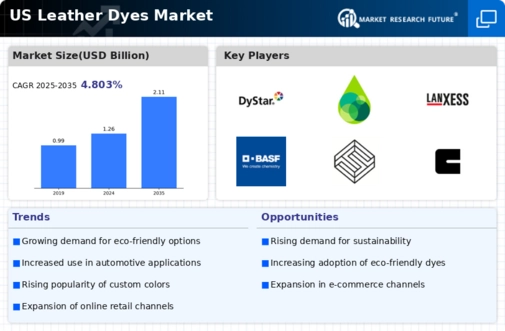The leather dyes market exhibits a dynamic competitive landscape characterized by innovation and strategic partnerships. Key players such as BASF SE (DE), Huntsman Corporation (US), and Clariant AG (CH) are actively shaping the market through their distinct operational focuses. BASF SE (DE) emphasizes sustainability in its product offerings, aligning with the growing demand for eco-friendly solutions. Huntsman Corporation (US) leverages its extensive research and development capabilities to introduce advanced dye formulations, while Clariant AG (CH) focuses on regional expansion and enhancing its supply chain efficiency. Collectively, these strategies foster a competitive environment that prioritizes innovation and sustainability, driving growth in the sector.
In terms of business tactics, companies are increasingly localizing manufacturing to reduce lead times and optimize supply chains. The market structure appears moderately fragmented, with several players vying for market share. However, the influence of major companies is significant, as they set industry standards and drive technological advancements. This competitive structure encourages smaller firms to innovate and differentiate their offerings, thereby enhancing overall market dynamism.
In October 2025, Huntsman Corporation (US) announced the launch of a new line of water-based leather dyes aimed at reducing environmental impact. This strategic move not only aligns with global sustainability trends but also positions Huntsman as a leader in eco-friendly dye solutions. The introduction of these products is likely to attract environmentally conscious consumers and strengthen the company's market position.
In September 2025, Clariant AG (CH) entered into a strategic partnership with a leading leather goods manufacturer to co-develop innovative dyeing processes. This collaboration is expected to enhance Clariant's product portfolio and provide tailored solutions to meet specific customer needs. Such partnerships are indicative of a broader trend where companies seek to leverage synergies to drive innovation and improve customer satisfaction.
In August 2025, BASF SE (DE) expanded its production capacity for leather dyes in North America, reflecting its commitment to meeting rising demand in the region. This expansion not only enhances BASF's operational capabilities but also signifies a strategic move to solidify its market presence amidst increasing competition. The ability to scale production efficiently is likely to provide BASF with a competitive edge in terms of supply chain reliability.
As of November 2025, current trends in the leather dyes market are increasingly defined by digitalization, sustainability, and the integration of artificial intelligence. Companies are forming strategic alliances to enhance their technological capabilities and streamline operations. The competitive landscape is shifting from traditional price-based competition to a focus on innovation, technology, and supply chain reliability. This evolution suggests that future differentiation will hinge on the ability to deliver sustainable and technologically advanced solutions, thereby reshaping the market dynamics.




















Leave a Comment